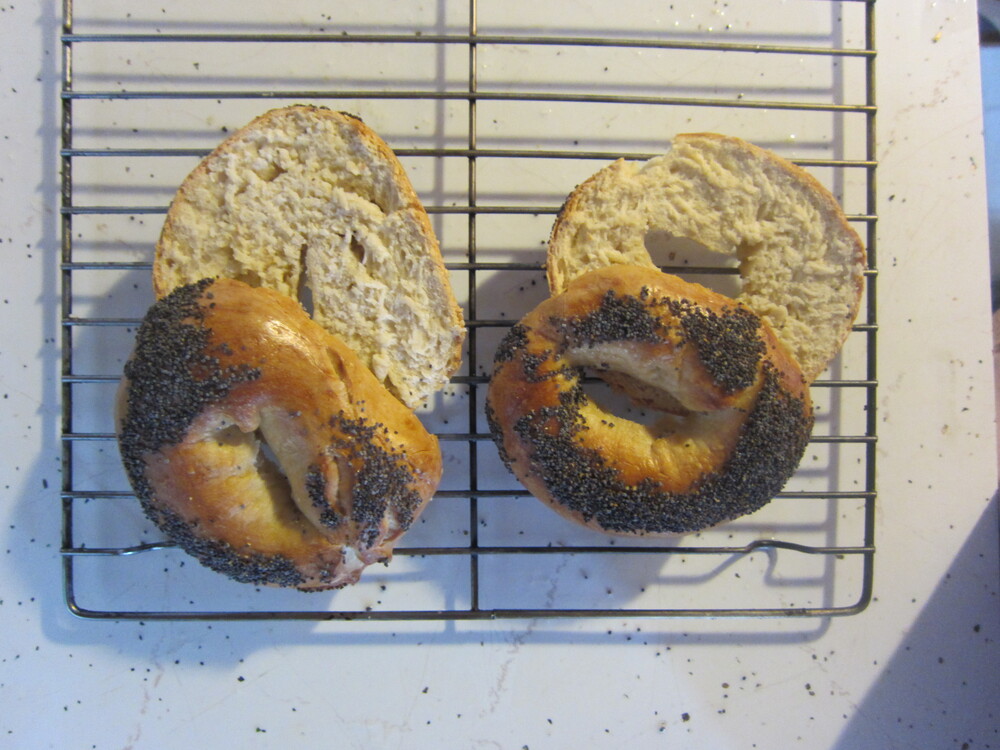I’ve probably made bagels 25-30 times at this point, and have reached a point where they turn out surprisingly well– not the best I’ve had in New York, but better then any bagel I can buy locally. Here’s my standard recipe, based on trying a few variants (I’ve even made two different recipes and done blind taste tests with friends). It’s very similar to the one in The New Best Recipe.
Before I dive in, the four things easily accessible to the home cook that seem to make the most difference in a good bagel:
- Letting the dough rise in the fridge for 12+ hours
- Using high-protein (high-gluten) flour such as King Arthur Sir Lancelot
- Boiling the bagels briefly before baking them
- Eating them fresh, within an hour
To make 12 bagels (you can scale this recipe up or down):
-
6 cups of King Arthur Sir Lancelot high-gluten flour
- Or, 6 cups of King Arthur bread flour + 6 tsp Bob’s Red Mill Vital Wheat Gluten sifted in with that flour (see also other flour options that work)
-
2 ¼ tsp active dry yeast (a standard packet)
-
1 Tbsp salt
-
1 ½ Tbsp barley malt syrup (available in markets, or brewing supply shops)
-
2 cups lukewarm water
Stir the above together into a smooth dough (this will take some elbow grease). It may feel like there’s not enough water at first, but after working it for a bit it should come together into a slightly stringy ball.
Knead the dough for 5-10 minutes (this is always longer than I think– I set a timer), until smooth and elastic. Divide it into 12 balls, and let them rest for 5 minutes.
Form each ball into a bagel shape by rolling it into a “dough snake” with slightly tapered/thinner ends and overlapping and firmly pressing these ends together, to make a hoop with a uniform diameter and no visible seam.
Put the bagels on a tray (dusted with cornmeal to prevent sticking), cover with plastic wrap, and let them rise in the fridge for at least 12 hours. I’m not kidding– 8 hours is not enough, and the two times I let them rise 15 hours they were noticeably better. They don’t rise a huge amount in the cold– it’s not like bread that doubles in bulk, but they should enlarge somewhat and become a little more soft/puffy to the touch.
Letting them rise in the fridge is important, because (according to TNBR) “At lower temperatures, yeast fermentation is suppressed, and the lactobacilli bacteria naturally present on grains and in yeast begin to produce a variety of organic acids, primarily lactic acid and acetic acid. The organic acids, the same acids present in a healthy sourdough culture, the dough a more complex flavor […] The richer, reddish brown color of the crust [after baking] was the result of another chemical process, called the Maillard reaction. During the retarding [low-temperature rising] process, enzymes produced by the bacteria convert wheat starch into simple sugar, which during baking produces a rich, toasty color and flavoring.”
The next day:
- Preheat the oven to 450F
- Remove the bagels from the fridge about 20 minutes before you want to bake them.
- Boil a big pot of water with 1 Tbsp of barley malt syrup in it
- I’ve read the rumors that New York water is the secret of a good bagel, and read of people putting various additives in the water to change the pH, but in my experience it’s not at all necessary for a good bagel– I’ve tried baking baking soda (not a typo) to make more alkaline sodium carbonate but didn’t notice a difference in the end product in my one trial.
- Boil each bagel for 40 seconds (depending on how they’ve risen, they may drop to the bottom of the pot and then rise after about 30 seconds… or they may float from the very beginning, in which case I flip them over after the first 20 seconds to make sure the entire surface sees the boiling water). This sets the size of the bagel and prevents it from just swelling up when you bake it, reactivates the yeast that’s been made sluggish by the cold, and helps give the bagel its shiny surface.
- Drain the bagels on a rack as they come out of the water, and optionally sift toppings (poppy seeds, sesame seeds, cracked pepper, caraway seeds, dried onion or garlic flakes, etc) onto them
- Bake them at 450 for about 20 minutes on a middle oven rack, until golden brown (your time may vary)
- Let them cool briefly on a rack, then slice and serve warm
If everything has worked, you should have something that looks like a bagel, with a crisp, crackling crust when you bite into it, a chewy but not too dense interior with a nice flavor, and a malty bread smell when you cut it open. Enjoy!
Some typical toppings: smoked salmon and trout (sometimes homemade), cream cheese, good tomatoes, red onion, capers. Alternate toppings: hummus, black olives, chives, cucumbers…
